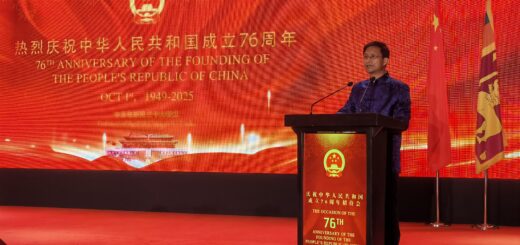PART 3 – 35 Indo-Lanka Agreements – Strategic Entrapment or Regional Partnership?

How India Could Leverage the 35 Agreements to Dominate Sri Lanka.
While bilateral cooperation between nations is common in an increasingly interdependent world, the sheer volume, strategic scope, and opaque execution of the 35 agreements signed between Sri Lanka and India from December 2024 to April 2025 have raised pressing concerns. These agreements span sensitive domains—defence, energy, digital governance, strategic ports, and critical minerals—making their cumulative impact far greater than the sum of their parts. Critics argue that India, already a regional hegemon, may be positioned to leverage these agreements not merely for mutual development, but to gain a commanding influence over Sri Lanka’s internal and external policy orientation.
This section examines the seven key domains where India could consolidate dominance—strategic, economic, technological, cultural, and political—based entirely on the text and implications of the signed agreements. Each domain is assessed for potential outcomes, legal risks, and sovereignty implications.
- Defence Pact – Strategic Entrapment
Agreement: Sri Lanka–India Defence Cooperation Pact (April 2025)
Potential Leverage:
- Indian Navy gains access to Sri Lanka’s EEZ and surveillance zones.
- Bilateral exercises and hydrography pave way for Indian maritime presence on strategic coasts.
- Use of Sri Lanka as a staging point for India’s Indo-Pacific or QUAD-aligned operations.
Risks:
- Undermines Sri Lanka’s traditional non-aligned stance.
- Draws Sri Lanka into regional rivalries, especially with China.
- Violates Article 157A if prejudicial to sovereignty.
- Energy & Trincomalee Hub – Resource Capture
Agreements:
- Tripartite Energy Hub MoU (India–Sri Lanka–UAE)
- Sampur Solar Expansion, Adani Wind Projects
- HVDC Grid Interconnection
Potential Leverage:
- Control of Trincomalee—a port of immense geopolitical value.
- India dominates upstream/downstream energy supply.
- Long-term dependency on Indian power grid.
Risks:
- Parliament bypassed in agreements on natural resources.
- Loss of flexibility in energy policy and sovereignty.
- Digital Infrastructure – Data Sovereignty Erosion
Agreement: MoU on Digital Transformation (April 2025)
Indian Tools Introduced: Aadhaar-based ID system, DigiLocker, GovPay equivalents.
Potential Leverage:
- India potentially gains access to population-level citizen data.
- Administrative and electoral systems tied to Indian tech.
- Limits Sri Lanka’s tech diversification or neutrality.
Risks:
- Violates UN Privacy Rights.
- Weakens national cybersecurity.
- May violate local data protection laws if data hosted externally.
- Surveillance & Maritime Coordination – Loss of Naval Autonomy
Agreements:
- Maritime Rescue Coordination Centre
- Hydrography Cooperation
- Deployment of Dornier Aircraft
Potential Leverage:
- India monitors vessel traffic through Sri Lankan waters.
- Real-time naval intelligence creates operational dependency.
- Reduces Sri Lanka’s freedom to engage third parties like China.
Legal Risks:
- Could conflict with UNCLOS if Indian authority extends over Sri Lanka’s EEZ.
- Lack of SOFA (Status of Forces Agreement) transparency.
- Critical Minerals & Industrial Capture
Agreements (Implied or Undisclosed):
G2G MoUs on phosphate, ilmenite, and graphite mining.
Potential Leverage:
- India gains access to rare earths and minerals vital for energy and tech industries.
- No competitive bidding or public scrutiny of licensing or royalties.
- Local industries unable to compete with Indian-scale capital and tech.
Risks:
- Breaches Article 33 (Presidential duties) and Article 14A (RTI).
- Resource nationalism undermined.
- Aid to Specific Provinces – Ethno-Political Asymmetry
Agreements:
- LKR 2.4 billion grant to Eastern Province
- Cultural revival of kovils, relic transfers, Ramayana Trail
Potential Leverage:
- Cementing India’s cultural soft power in Tamil-majority areas.
- Long-term influence over local leadership and youth.
- Fosters regional identities misaligned with national unity.
Risks:
- Undermines Article 9 (foremost place to Buddhism).
- Violates constitutional unitary status if used to support separatist narratives.
- Lack of Transparency – Collapse of Democratic Oversight
Observation:
- None of the 35 agreements were tabled before Parliament.
- Key terms not disclosed to public or media.
- No stakeholder consultations or Cabinet-level transparency.
Implications:
- Violates democratic norms and RTI Act.
- NPP’s own commitments to transparency contradicted.
- Paves way for future foreign agreements to bypass public review.
In combination, the 35 agreements signed under President Anura Kumara Dissanayake’s government open unprecedented channels for India to exert strategic, economic, and technological influence in Sri Lanka. While some elements may serve short-term developmental goals, the long-term risks to sovereignty, autonomy, and constitutional integrity are profound.
Future cooperation with any nation must uphold not only national interest but also public trust, constitutional legality, and long-term independence. Part 4 will examine the domestic reactions and ideological implications, especially the perceived reversal of the JVP/NPP’s longstanding foreign policy stance.







